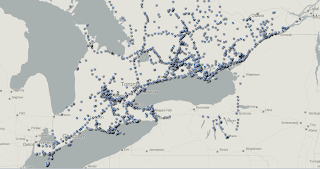| adult female Brown Booby from Cuba in 2006 |
This bird has already made the news media too - check out this story from the St. Catharines Standard, this clip from CHCH news, and a story on The Buffalo News.
Anyways, I wanted to give some tips for those that might try for this bird later this week or this weekend.
Be prepared:
First, if you have a smart phone be sure you are subscribed to Ontbirds and Genessee Birds - that way you'll know if anyone is seeing it on either side of the river. You can also just check the listings on the web for those - Ontbirds archives and Genessee Birds archives. If you are an Ontario birder, you need to know that Canadian cell service is pretty poor along the river so be prepared for American signals - consider a prepaid voice/data package from you regular cell phone provider so you can use the American signal without paying more than your binoculars (alternatively you can just wait until your next bill and try to get them to remove the charges since you didn't leave the country).
If you are going to be there in the morning, polarized sunglasses will help cut the glare from the sun, which unfortunately you will have to deal with. Of course, you need a scope as the bird has been mostly on the far side of the river. It has been quite cool both mornings - I've been happy to have a winter hat and gloves for the first hour or so of the day.
Know the bird's routine
It looks like a pattern is developing for this bird. Between 7:30 and 8:30 it has been seen between the red-roofed building and the Peace Bridge before heading towards the lake and disappearing for a long period of time. I think this bird roosts somewhere in this vicinity, gets up and flies around for a bit then goes somewhere to feed. Then it seems like it comes back mid-afternoon (after 2 pm) and spends a lot of time resting on Donnelly's Pier for most of the rest of the day. It seems like later in the day is more reliable, but you might be less likely to get the bird in Canadian water (if you care about that!).
Know where to look
So far, almost all of the observations in Ontario have come from a small parking lot at Mather Park across from Old Fort Erie. From there you can see several key landmarks (as summarized by Willie D'Anna here).
-Mather Park parking lot - Ontario birders are parking here and viewing from this general area
-Erie Basin Marina tower - This is where a lot of American birders are watching from. You can easily see this tower (and see if birders in it are getting excited!) through your scope from the Ontario side.
-Donnelly's Pier - This is the spot where the booby seems most likely to come to rest in the afternoon. It has a big sand/gravel deposit
-Reef Lighthouse - 42.881273, -78.915133 (not visible on Google). This is the old frame of a building on a big rock reef where cormorants like to hang out. On October 8 the booby was sitting here at dusk. This structure is in American waters but it is only about 50 m east of the international border.
-Red-roofed building - 42.879589, -78.915133 (not visible on Google). This is also known as the water intake building. It is a good reference point when searching.
Here is the map (click here to open in new window) showing those locations.
Update: here are some distance measurements:
Mather Park to Donnelly's Pier (NW tip) = 1.95 km
Mather Park to Reef Lighthouse = 1.41 km
Mather Park to Red-roof Building = 1.72 km
Mather Park to Erie Basin Marina tower = 2.79 km
Mather Park to international border = 0.96 km (shortest distance, which happens to be in a straight line towards Erie Basin Marina tower)
Erie Basin Marina tower to international border = 1.83 km (shortest distance, which happens to be in a straight line towards Mather Park)
Erie Basin Marina tower to Donnelly's Pier (NW tip) = 0.93 km
Erie Basin Marina tower to Reef Lighthouse = 2.08 km
Erie Basin Marina tower to Red-roof Building = 1.88 km
If you're interested, here is a screen shot of a bit better resolution map showing the Reef Lighthouse and the red-roofed building with the international border shown:
 |
| The reef lighthouse (upper left), red-roof building (lower right) and international border |
southwestern Ontario imagery layer and set the transparency to about 75% to be able to see the structures and the border.



